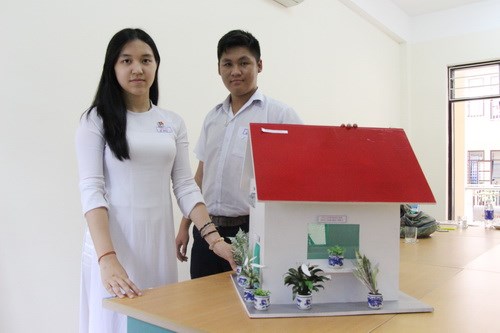
Quach Duc Huy, one of two students, said he began thinking of creating the house after watching the TV news about local residents in the polluted areas trying to prevent garbage-carrying trucks from entering the dumping ground.
Huy and Tran My Duyen, another student, and their teacher visited the site to learn about the real situation there and discuss the solutions.
“The houses locals live in are mostly not solid. There is also a stone exploitation site in the areas. Locals not only bear the bad odor from the dumping ground, but also have to breathe the polluted air caused by the site,” Huy said.
They also discovered that toxic gas was emitted as they burn the waste to get copper.
With the machine borrowed from the Da Nang University, they took measurements about the environment.
The house for people must be cheap, durable and easily implemented, because the majority of locals are poor and they need low-cost houses.
They decided that the house for people must be cheap, durable and easily implemented, because the majority of locals are poor and they need low-cost houses.
“Developing greenery which helps filter the air, absorb polluting substances, kill mosquitoes and drive snakes away is the main solution,” Huy said, adding that some kinds of plants have been suggested for growing inside the house.
Huy and Duyen also apply some other technique solutions for the house. They used paints containing titanium dioxide to cover the roofing and the yard to oxidize toxic gas. Meanwhile, windows are made of plastics-coated fiberglass.
Titanium dioxide is highly resistant to corrosion, is waterproof and chemically durable, able to react to light to neutralize the effects of air pollutants. It is a photocatalytic substance which can oxidize the air pollutants emitted during the burning of hazardous fossil fuels,” Huy explained.
“When it is exposed to natural light, TiO2 breaks the nitrogen oxides in the air and turns them into harmless calcium nitrate. Calcium nitrate will wash the roof in the conditions of normal rainfall and is a common fertilizer for plants,” he said.
The main door to the house is designed to look like the sail which can be regulated manually in order to avoid dust and toxic gas.
According to Huy and Duyen, it would take about VND10 million to upgrade an existing house covering an area of 100 square meters into the special house.
No comments:
Post a Comment